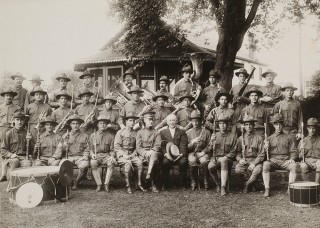Title

The 15th Band, Coast Artillery Corps, U.S. Army, Fort Hamilton, Brooklyn, 1917. Front row center, in civilian attire, is Arthur A. Clappé (faculty 1911-20), principal of the bandmaster training school on Governors Island. Rocco (Robert) Resta (Diploma ’13, Military Bandleaders Course), leader of the Fort Hamilton band, is second to the left of Clappé, holding a baton. To Clappé's right is Australian composer and pianist Percy Grainger, Army bandsman at Fort Hamilton, who enlisted in 1917 and was later transferred to Governors Island.
(Photo by J.J. Fisher, New York. From the collection of the Grainger Museum, University of Melbourne, Australia)This is one of several articles in a series about Juilliard's connections with the military.
Body
In the fall of 1909, Frank Damrosch, director of the Institute of Musical Art (the forerunner of modern-day Juilliard), watched the Hudson-Fulton Celebration parade from the Institute building, at Fifth Avenue and 12th Street.
As Damrosch wrote in his 1936 history of the school (Institute of Musical Art, 1905–1926), he “could not but be impressed by the fact that the worst music from all the bands we heard was that of the United States Army bands. I was so chagrined over this condition that … I requested that the Institute of Musical Art offer to the Secretary of War a certain number of scholarships for Army band musicians, in order that they might be trained to become competent band leaders and teachers of band musicians in the United States Army.”
Damrosch, who was president of the school from its founding in 1905 to his retirement in 1933, was able to realize his plan in 1911 with the establishment of the Military Band Department of the Institute of Musical Art, offering a rigorous two-year course of study for the training of Army bandmasters. Five men were admitted each year, selected by examination from an Army-wide field of applicants; 48 eventually graduated.
Every summer I am enjoyably occupied researching this and similar topics as a volunteer at Governors Island National Monument, which is run by the National Park Service. Located off the southern tip of Manhattan, Governors Island was a military installation from the mid-18th century until the Coast Guard’s departure, in 1996. It is now a historic site and public park.
Music has been a significant feature of the island’s history. A military music school, one of only two in the country, was established in the 1830s. Apparently it ceased to exist sometime in the 1880s; the idea of formal training for Army musicians seems to have languished until Frank Damrosch heard those bands in 1909.
The bandmaster curriculum had two main components. Theory, harmony, counterpoint, ear training, and related subjects were taught at the Institute, which in 1910 had moved to a new building near Broadway and 122nd Street (home of the Manhattan School of Music after Juilliard left for Lincoln Center in 1968). Practical training—in conducting, band management, and performance on every band instrument—took place on Governors Island, where the men were stationed. Soon a course was added for band musicians, who received instruction while serving in the Recruit Practice Band, conducted by the bandmaster students. For a few years, additional practice ensembles were formed using prisoners held in Castle Williams, one of Governors Island’s 19th-century forts; musical training was thought to be a means of improving character and developing a potential job skill for life post-prison.
In 1921, the Army Music School, as the program was renamed, moved to the War College, in Washington, D.C., and its affiliation with the Institute was discontinued. The Army School itself was closed in 1928, partly due to Army downsizing and perhaps also to the fact that a sufficient number of qualified bandmasters were thought to be available. It was reactivated during World War II, and today exists as the U.S. Army School of Music, based in Virginia Beach, Va.
There is more to be learned about the history of the bandmaster’s school and Juilliard’s connection to it. We would be pleased to hear from readers of The Journal who have information or leads regarding music on Governors Island from any time period. Contact us at journal@juilliard.edu or (212) 799-5000, ext. 340.
Aside from its historical interest, the Island is a unique and beautiful place to visit. It is located only a short ferry ride from Lower Manhattan. The public-access season is expected to run from May 28 through the last weekend in September. See you there!




